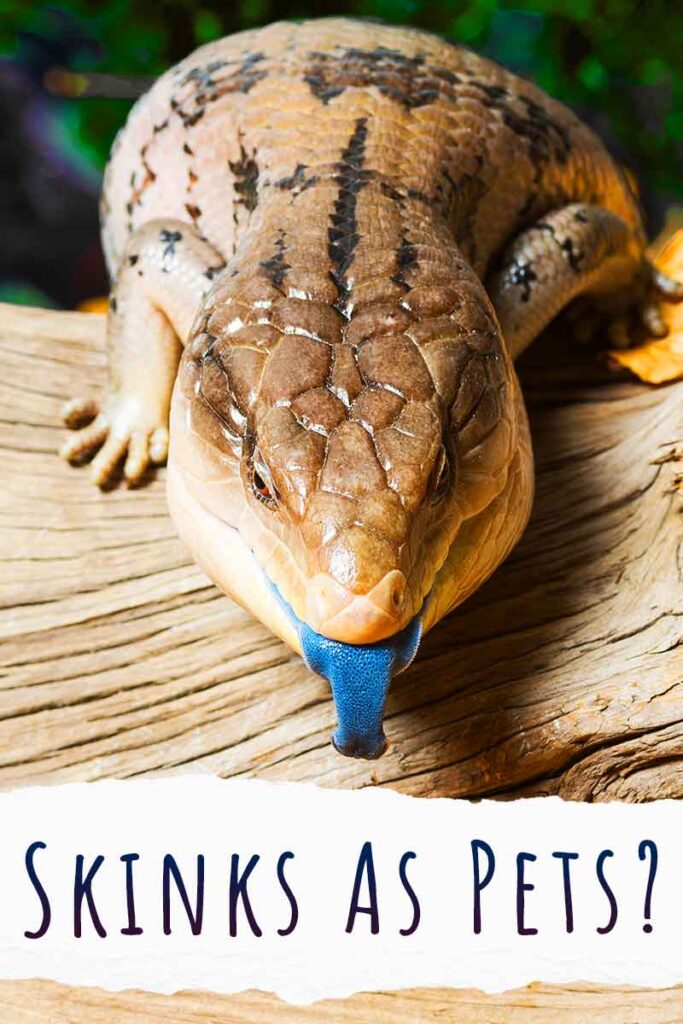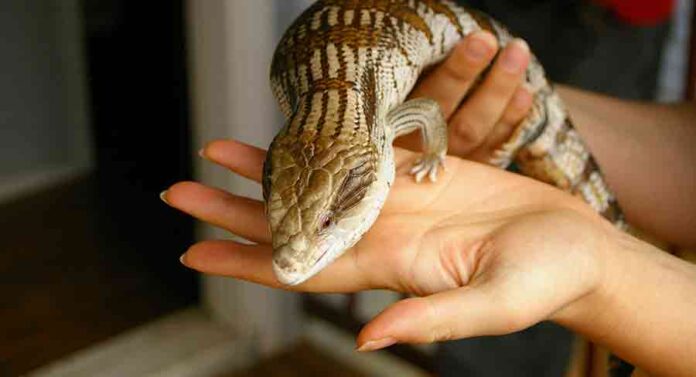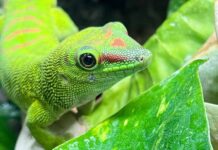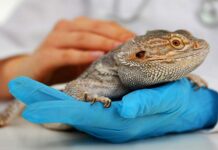Keeping skinks as pets can be a fun and rewarding pastime.
There are several varieties of pet skink, each with their own temperament and care needs.
So choosing the right type is key to getting the most enjoyment out of them.
Skinks as pets
Skinks are not a single species.
In fact, they are a whole family of lizard types, comprising well over a thousand separate species.
Most of these live exclusively in the wild. But a small number are also bred in captivity and kept as pets.
Types of skinks kept as pets include:
- Berber skinks, also known as Schneider skinks
- Blue tongue skinks
- Blue tailed skinks
- Fire skinks
- Cunningham skinks
- Common garden skinks
- Monkey tail skinks
- Red eyed crocodile skinks
Let’s look more closely at some of the most popular varieties.
The blue tongue skink as a pet
Blue tongued skinks (pictured below) are the most widely owned pet skinks.

They are native to Australia and New Guinea, where they’re affectionately known simply as ‘blueys’.
Their tongue isn’t just a little bit blue in the right light either – it’s a really bright blue, which evolved as a defensive display to ward off predators.
It’s so striking and unusual that it’s hardly surprising these lizards are popular and sought after reptile pets.
Happily, they’re also the easiest to tame and handle of all the skink species.
Their docile nature means they’re often recommended as a good first pet for budding new herpetologists.
FUN FACT: Several species of sinks have blue tongues, but the most widely available as a pet is the eastern blue tongued skink, also known as the common blue tongued skink.
Cunningham skinks as pets
Another Australian native, Cunningham skinks reach about the same size as blue tongued skinks (15 to 20 inches long).
But whilst blueys have smooth scales all over, Cunninghams are known for their spiny tails.
Besides their ‘wild type’ coloring, which varies from reddish brown to back, some breeders also specialize in continuing lines of eye-catching albino Cunninghams, which are pale cream.
Cunningham skinks are more skittish than blue tongue skinks, and less suitable for handling. But they make up for it by being more active and fun to watch in their vivarium!
Common garden skinks as pets
Common garden skinks are one of the smallest skinks kept as pets, reaching just 3 to 6 inches long.
Once again they’re native to Australia, but they’ve also been observed in the wild in the U.S., Africa, and Europe – possibly as a result of unwanted pets being released into the wild.
Even though wild common garden skinks will quite often allow themselves to be picked up, many areas have regulations against trapping them in the wild.
So look for a breeder who rears them in captivity. It’s the best way to avoid bringing home a pet with unwanted parasites too!
Caring for skinks as pets
Skinks, like lots of reptile pets, are relatively low maintenance once you get established.
But if you’re new to keeping them, you’ll need to invest in a fair bit of specialist kit to get started.
And since each skink species needs quite specific conditions in their vivarium, it’s best to visit a specialist reptile pet store, or ask your breeder for a list of equipment in advance.
They can also tell you how to set up your skink’s habitat, and maintain it at optimum conditions.
Let’s look at some more details of caring for skinks as pets.
Diet
Most skinks are opportunistic predators, meaning they eat what they can, at the point they come across it. Their main prey are insects, although larger skinks might also hunt small rodents.
They top up their diet with plant matter.
Blue tongued skinks are one of these omnivore varieties. They need a diet which is 50% leafy vegetables, 25% fruit, and 25% live insect prey.
Blue tailed skinks eat mostly insects, and monkey tailed skinks are entirely vegetarian.
Whichever species you choose, you’ll need to dust their food with powdered calcium to keep them healthy.
Habitat
The space, temperature and humidity your pet skink needs inside their vivarium depend upon which species you choose.
Some love to climb, whilst others need a moisture retentive substrate to meet their humidity needs.
Skinks digest and poop food pretty quickly by reptile standards, and they are notorious culprits for soiling their water bowl.
So their habitat needs to be spot cleaned to remove droppings and refresh their water every day.
You should also remove any uneaten food at the same time and replace it with fresh.
How frequently the vivarium needs completely emptying and disinfecting depends again on species.
Are skinks as pets healthy?
Common health problems of skinks include:
Dysecdysis
This is the medical term for difficulty shedding, and it’s usually a result of being housed in a too-dry habitat.
Retained skin can cause the tissue underneath to die off, so that toes, limbs or the tail have to be amputated.
Monitoring humidity in their habitat and giving warm water baths during skin shedding can help prevent it.
Gastrointestinal parasites
These are particularly a problem for pet skinks caught in the wild.
So, make sure you buy a pet skink which has been bred in captivity.
Injuries from other skinks
Skinks are solitary animals and best kept alone.
Mixed sex pairs can live together peacefully in a large enough enclosure, but males are likely to fight.
They particularly tend to bite each others’ heads and feet, which can result in death or amputation.
Obesity
Too much food, or an unbalanced diet can cause obesity.
Stomatitis
Also known as mouth rot, is a bacterial infection of the tissues inside the mouth.
It most commonly sets in when the lizard is under stress, so the best way to avoid it it by making sure their habitat and diet are all well matched to their needs.
In order to give your skink the best chance of recovering from any of these conditions, it is wise to find out where your nearest veterinary clinic with a reptile specialist is before you bring your new pet home.
What skinks make the best pets?
With so many types of pet skinks available, it can feel difficult to pick the right one.
And with an average lifespan of 20 years, getting it wrong is not a mistake you’ll be freed from in a hurry!
Talk to other skink owners, breeders, and specialist reptile pet stores about what you can offer a skink, and what you’re hoping to get in return.
For example, if being able to handle your skink is important to you, then a placid, slow moving variety like the common blue tongued skink might suit you best.
But if you want a skink which is fun to observe but you’re not bothered about handling them, then you might choose a Cunnnigham skink.
Another consideration is diet. Some skinks are highly insectivorous – there’s no avoiding that they need regular meals of live prey.
If this doesn’t appeal to you, consider varieties which don’t mind small portions of wet cat food instead, or even the completely vegetarian monkey tailed skink.
Finally, some skinks need larger and more complex habitats than others.
For example blue tongued and monkey tailed skinks are both relatively large species and need more space. And the red-eyed crocodile skink needs high humidity, and has low tolerance for being allowed to dry out.
Do skinks like to be handled?
As you’ve probably gathered… it all depends on species!
Blue tongued skinks are widely thought of as being the easiest to handle.
This is because they are slow moving, and easily won over with edible treats!
At the other end of the spectrum, blue tailed skinks are famous for fighting tooth and nail against being handled.
Will a skink bite you?
All skinks will bite if they feel threatened. Some skinks are quicker to feel threatened than others, and bite whenever they are handled.
To get a skink used to being handled, let them get used to you without reaching for them for several days after they arrive.
Even if a skink does bite you, their teeth are rounded and not very sharp. So the chances of them hurting you are slim.
Are skinks good pets?
Skinks are fun and unusual pets, and good conversation starters, in the right homes.
All varieties of skink need carefully constructed and maintained habitats.
But once settled in, they’re typically low maintenance. And some of the more active types are entertaining to watch.
Don’t forget, they can live up to 20 years, so think hard before you commit to skinks as pets, because you’ll be in it for the long haul!
Do you already have a pet skink?
Tell us about them in the comments box down below!
Alternative unusual pets
- Giant African Land Snail – Can You Keep This Mighty Mollusc As A Pet?
- Baby Snapping Turtle – Wild Creature Or Perfect Pet?
- Spider Ball Python – What Should You Know About This Morph?
- Is A Pet Gecko The Right Choice For You?
References
Doneley et al. Reptile Medicine and Surgery in Clinical Practice. John Wiley & Sons Ltd. 2018.
Manicom & Schwarzkopf. Diet and prey selection of sympatric tropical skinks. Austral Ecology. 2010.
Shea. Diet of two species of bluetongue skink. Australian Zoologist. 2006.
Stahl. Pet lizard conditions and syndromes. Seminars in Avian and Exotic Pet Medicine. 2003.















